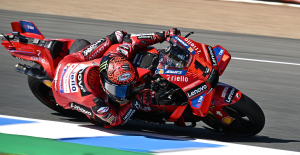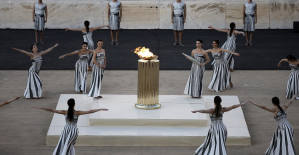What is it like to be a donkey? One tends to mistake someone who claims to know the answer for an ass himself. In 1974, the philosopher Thomas Nagel declared the transgression of one's own identity to be impossible, using the bat as an example. Only art comes closest to an idea.
The Polish-Italian film "Eo", which should be correctly translated into German as "Ia", the sound donkeys make in this country (which would, however, drop the Latin meaning "of him"), tells life for 86 minutes a donkey's point of view. The 84-year-old director Jerzy Skolimowski has taken a highly speculative venture that could easily have turned into monotonous documentary or an avant-garde experiment for a small, very specific audience. But surprisingly, a classic, breathtaking, almost all too human tragedy unfolds before the viewer's eyes, consisting of love, greed, jealousy, intrigue, murder and violence.
Like a lost wanderer, the long-eared trotts from one station to the next, through Polish and Italian landscapes, sometimes alone, sometimes in company. His journey takes him from a circus to a horse farm, a children's farm, a forest, a football festival, an infirmary, a fur company and a villa garden to the slaughterhouse. Where the donkey is usually regarded as the Bartleby among animals, here he appears more as the incarnation of an Eichendorff good-for-nothing. Because instead of standing still stubbornly, he lets himself drift further and further, even when it would be wise to pause.
Eo is played by six different donkeys, Hola, Tako, Marietta, Ettore, Rocco and Mela. The credits indicate that no animals were harmed during the shoot. "Eo" is a film about our dealings with animals, the donkey is traded as a load puller, circus artist, football mascot and sausage content. But the fact that he is not only trampled upon but also resigns, seemingly willingly escaping places where he could have spent an idyllic retirement, keeps the film from becoming a depressing indictment of animal suffering. It is true that the stoic in the gray tails is treated badly, but just as often one means well with him.
This masterpiece of ambivalence renounces all black-and-white thinking – is the donkey really freer after being rescued from the circus, even if all he knows is the world between the stage, sparklers and cage? Is the man doing the right thing who unties the donkey from the fire truck by shouting "anarchy" after we have just seen him in nightmarish sequences living through a nightmare night alone in the wild forest from which he finally found his way back to civilization?
And are the vagabonds doing a good deed when they coldly slit the throat of a helpful truck driver to steal his money, inadvertently freeing the donkey locked in the back of his fate in the meat factory? The unusual charm of this gentle, loud, big story lies in the elimination of the contrasts between freedom and imprisonment, nature and culture, good and evil, love and hate.
So how do you tell the world of a donkey without slipping into the fantastic, Disney-like? "Eo" owes much of its breathtaking pull to the camera work, the editing and the music. Atmospheric flights charged with menacing tones from a drone perspective meet red donkey dreams, for example of an electric animal, and zoomed in close-up nostrils, which the arrogant-warlike horses flare at the arrival of the modest, peaceful donkey. The camera caresses Eo's fur lovingly.
Sometimes we see the surroundings blurred out of his eyes, sometimes we look into his eyes, and then again we see things that he doesn't even witness. This doesn't come across as undecided, but exudes the same risky freedom that the film pulsates and hypnotically raises as its theme.
Without ever hearing Eo's thoughts or voice, the film's camera pans and sequence of scenes alone suggest that this driven hero's dramatic journey is colored by a basic longing: that of the circus artist Kasandra, with whom he has performed so often together. Romantics would say he misses his first love and will do anything to find her, even if it means going from caring peasants back to brutal circus owners. Animal rights activists would counter that the donkey is a traumatized individual afflicted with Stockholm Syndrome, seemingly lost to a healthy life in the countryside.
In both cases, love marks a toxic concept in keeping with the times. Realists, however, can decide not to impose any narrative meaning on the episode-like sequence of scenes and to understand the animalistic straying less as a fable about the return of the prodigal son and more as impulsive arbitrariness. The film allows for all of these interpretations – Eo can be humanized or understood in all its animalistic strangeness.
Where the donkey often seems very close to us in its actions, the people and their behavior become increasingly alien to us. When the time has come for Isabelle Huppert to appear as a countess and throw the dishes at her pastor's son's feet, nothing can really shock you anymore. Eo patiently exposes human actions and rules as absurd and hilarious just by watching.
Even Skolimowski's explicit role model, Robert Bresson's classic "For Example Balthasar" from 1966, which was once again included in the authoritative critics' survey of the magazine "Sight and Sound" among the 100 best films of all time, was an annoyance for many. Ingmar Bergman said he was so bored with the film that he slept through it. "A donkey is completely uninteresting to me, but a human is always interesting," he explained to himself. In the screening of "Eo" at the Berlin "Around the World in 14 Films" festival in the Kulturbrauerei, a spectator leaves the hall in the middle. "Fucking movie," he scolds out loud. But Eo trudges on undeterred.
Some critics may also be bothered by the blatant stepping into overly large hoofpads. But the remake snorts so stubbornly that this never becomes its undoing. Compared to the black and white, almost conventionally filmed "Balthasar", "Eo" impresses with a more revolutionary aesthetic; also, the animal's suffering no longer weighs so one-sidedly on its back as in the Christian-tinged Martyrdom from 1966. Despite or because of the ambivalent reactions it triggers, it could impress the cinematic memory just as strongly as its predecessor. After its premiere in Cannes, where it shared the jury prize with two other works, the "New York Times" voted it number 1 of the best films of 2022. Poland will send him into the Oscar race in March.
Normally, the focalized figure shows us what we are meant to feel. When she cries, we cry with her; when she frowns, we begin to doubt. But Eo does nothing. He just stands or walks. Sometimes he breathes louder. What we should think is now entirely up to us.

 War in Ukraine: when kyiv attacks Russia with inflatable balloons loaded with explosives
War in Ukraine: when kyiv attacks Russia with inflatable balloons loaded with explosives United States: divided on the question of presidential immunity, the Supreme Court offers respite to Trump
United States: divided on the question of presidential immunity, the Supreme Court offers respite to Trump Maurizio Molinari: “the Scurati affair, a European injury”
Maurizio Molinari: “the Scurati affair, a European injury” Hamas-Israel war: US begins construction of pier in Gaza
Hamas-Israel war: US begins construction of pier in Gaza First three cases of “native” cholera confirmed in Mayotte
First three cases of “native” cholera confirmed in Mayotte Meningitis: compulsory vaccination for babies will be extended in 2025
Meningitis: compulsory vaccination for babies will be extended in 2025 Spain is the country in the European Union with the most overqualified workers for their jobs
Spain is the country in the European Union with the most overqualified workers for their jobs Parvovirus alert, the “fifth disease” of children which has already caused the death of five babies in 2024
Parvovirus alert, the “fifth disease” of children which has already caused the death of five babies in 2024 Inflation rebounds in March in the United States, a few days before the Fed meeting
Inflation rebounds in March in the United States, a few days before the Fed meeting Video games: Blizzard cancels Blizzcon 2024, its annual high mass
Video games: Blizzard cancels Blizzcon 2024, its annual high mass Falling wings of the Moulin Rouge: who will pay for the repairs?
Falling wings of the Moulin Rouge: who will pay for the repairs? “You don’t sell a company like that”: Roland Lescure “annoyed” by the prospect of a sale of Biogaran
“You don’t sell a company like that”: Roland Lescure “annoyed” by the prospect of a sale of Biogaran Exhibition: in Deauville, Zao Wou-Ki, beauty in all things
Exhibition: in Deauville, Zao Wou-Ki, beauty in all things Dak’art, the most important biennial of African art, postponed due to lack of funding
Dak’art, the most important biennial of African art, postponed due to lack of funding In Deadpool and Wolverine, Ryan and Hugh Jackman explore the depths of the Marvel multiverse
In Deadpool and Wolverine, Ryan and Hugh Jackman explore the depths of the Marvel multiverse Tom Cruise returns to Paris for the filming of Mission Impossible 8
Tom Cruise returns to Paris for the filming of Mission Impossible 8 Skoda Kodiaq 2024: a 'beast' plug-in hybrid SUV
Skoda Kodiaq 2024: a 'beast' plug-in hybrid SUV Tesla launches a new Model Y with 600 km of autonomy at a "more accessible price"
Tesla launches a new Model Y with 600 km of autonomy at a "more accessible price" The 10 best-selling cars in March 2024 in Spain: sales fall due to Easter
The 10 best-selling cars in March 2024 in Spain: sales fall due to Easter A private jet company buys more than 100 flying cars
A private jet company buys more than 100 flying cars This is how housing prices have changed in Spain in the last decade
This is how housing prices have changed in Spain in the last decade The home mortgage firm drops 10% in January and interest soars to 3.46%
The home mortgage firm drops 10% in January and interest soars to 3.46% The jewel of the Rocío de Nagüeles urbanization: a dream villa in Marbella
The jewel of the Rocío de Nagüeles urbanization: a dream villa in Marbella Rental prices grow by 7.3% in February: where does it go up and where does it go down?
Rental prices grow by 7.3% in February: where does it go up and where does it go down? Even on a mission for NATO, the Charles-de-Gaulle remains under French control, Lecornu responds to Mélenchon
Even on a mission for NATO, the Charles-de-Gaulle remains under French control, Lecornu responds to Mélenchon “Deadly Europe”, “economic decline”, immigration… What to remember from Emmanuel Macron’s speech at the Sorbonne
“Deadly Europe”, “economic decline”, immigration… What to remember from Emmanuel Macron’s speech at the Sorbonne Sale of Biogaran: The Republicans write to Emmanuel Macron
Sale of Biogaran: The Republicans write to Emmanuel Macron Europeans: “All those who claim that we don’t need Europe are liars”, criticizes Bayrou
Europeans: “All those who claim that we don’t need Europe are liars”, criticizes Bayrou These French cities that will boycott the World Cup in Qatar
These French cities that will boycott the World Cup in Qatar Basketball: Strasbourg appeals the victory recovered by Monaco
Basketball: Strasbourg appeals the victory recovered by Monaco Top 14: UBB with Tatafu and Moefana against Bayonne
Top 14: UBB with Tatafu and Moefana against Bayonne MotoGP: Bagnaia dominates qualifying practice in Spain and sets track record
MotoGP: Bagnaia dominates qualifying practice in Spain and sets track record Olympic Games: in Athens, Greece transmits the Olympic flame to France
Olympic Games: in Athens, Greece transmits the Olympic flame to France


















